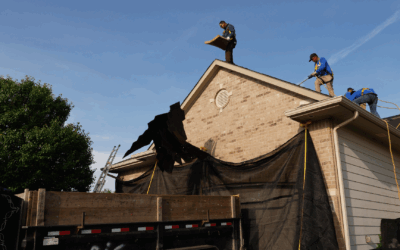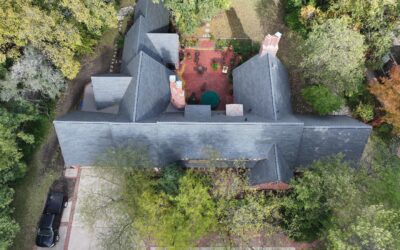What Are Open and Closed Valleys and What Do They Do?
A roof valley is the intersection between two slopes on a roof. They function like highways for water, concentrating water runoff into a narrow path that leads toward the gutters. Because valleys handle concentrated water flow, they are among the roof’s most vulnerable points, especially when improperly installed or maintained.
There are two types of valleys.
- Open Valleys – Also called metal valleys, these have an exposed strip of metal flashing that continues under neighboring shingles. Because metal is waterproof, this provides the greatest protection against water infiltration.
- Closed Valleys – These protect the valley using shingles that are cut to abut each other (i.e., closed-cut valleys), or overlap each other at the center of the valley (i.e., woven valleys). While they are more seamless in appearance, they rely on shingle and underlayment integrity to prevent water infiltration, and should not be used on slopes of 4:12 or lower.
See our article comparing open and closed valleys to learn more.

Expected Service Life of Open & Closed Valleys
Valleys themselves don’t have a typical lifespan. Their longevity depends on the roof system they’re a part of, from the shingles abutting or comprising them to the underlayment below them. A properly installed open valley is likely to last as long as the roof itself, while a poorly sealed closed valley might fail in under a decade with heavy rainfall.
Valleys are one of the roof’s most vulnerable areas, but they rarely leak. What homeowners often describe as a “valley leak” is usually water infiltration up slope or adjacent to the valley. Think of it like a riverbed: it carries water safely away, but a logjam upstream (e.g., a dormer wall, dead valley, or an improperly tied-in area) causes pressure to build and forces it into vulnerable areas.
The valley itself is rarely a source of leaks; the real challenge is in how well it’s integrated with the roof system. In this article, we’ll focus specifically on the valley system itself, not the surrounding components that may influence it.
0-5 Years: New Installation – Evaluating for Correct Installation
A correctly installed valley should sit flush to the roof and effectively channel water toward the roof’s drainage system: the gutters. They
- (Closed) Untrimmed Top Corners: If the corners of shingles along the “cut” side of the valley aren’t trimmed, water can trace along those edges either 1) onto the field of the roof, or 2) underneath the overlapping shingles in the valley. Untrimmed shingle corners will appear like a square overlap on the valley, where it channels water into more vulnerable areas.
- Exposed Fasteners: Exposed fasteners on the field of your roof should always be sealed. This is especially true for valleys, which might channel 20 gallons of water per minute during heavy rain. Closed valleys with exposed nail heads through the shingles have an immediate access point for water: a hole. Improperly installed metal valleys may have nails driven through the valley metal. The valley metal extends under the adjacent shingle courses, which is where fasteners are placed. Fasteners should not be located on the exposed portion of the metal.

- Oversized Gap in Decking: The valley itself doesn’t have designated boards of decking. Instead, it’s supported by the decking from both slopes that meet in the valley. If there’s a sizeable gap between those boards of decking, the materials protecting the valley don’t have a solid foundation, resulting in myriad issues down the road (e.g., shingle uplift and poorly secured underlayment). During the valley’s installation, if sizeable gaps are present, they are bridged with cut panels of OSB first.
- (Open) Space Between Metal Valley Runs: Valleys that change direction at shallow angles or run an extended length require separate pieces of metal flashing. The second piece of flashing runs under the first piece to ensure water doesn’t infiltrate the gap between pieces. If this gap isn’t protected by proper metal flashing overlap and ice and water shield, it can become a source for leaks.
10-40 Years: Normal Weathering – What to Monitor
Newton’s law of motion states that an object at rest will remain at rest until an external force influences it. For valleys, those external forces are constant: flowing water, followed by UV radiation and debris accumulation. A valley’s job is to channel water, so it gets a lot of external force.
Fortunately, normal wear for a well-installed valley is mainly cosmetic: discoloration, minor granule loss in closed valleys, or light wear on exposed metal. The definition of a successful roof is simple: keep water out. If the symptoms below describe your valley, then it is still performing it’s one job, but some maintenance is recommended to make sure its lifespan is as long as the roof around it.
- Debris Buildup: Twigs, leaves, acorns, or nesting materials can collect in valleys, slowing drainage. Valleys are designed to channel water to the roof’s drainage system, not hold standing water indefinitely. When debris obstructs water flow, it should be cleared — especially where the valley meets the gutter line, where buildup is most likely to occur.
- Degranulation (Closed): Granule loss in closed valleys occurs more rapidly than in the field of the roof due to the volume of water valleys channel. Repairs are usually not necessary unless granule loss is widespread or leaks have already occurred.
- Surface Discoloration: You’ll likely see smoother, darker asphalt showing through the shingles a few years after a closed valley installation. This is a symptom of granule loss exposing the fiberglass mat underneath. Metal valleys may develop staining, either as white mineral deposits from coating breakdowns or as small patches of reddish-brown oxidation – an early sign of rust. Metal valleys will also naturally discolor over time from UV radiation, especially if it’s painted.
- Minor Denting (Open): Light dents can result from hail strikes, foot traffic, or tree limb impacts. Open valleys typically use metal gauges thick enough to prevent superficial dents from affecting the coating, preserving the valley’s integrity. Unless the denting is severe enough to create a low point or otherwise displace water from its intended runoff path down the valley, performance is unaffected.
Maintenance: Periodic cleaning. None of the conditions cited above will compromise the valley’s ability to shed water, but accumulated debris traps moisture and allows the valley metal to corrode under standing water. Keeping valleys clear ensures they can continue channeling water efficiently, which allows both the valley and neighboring shingles to perform as intended.
20-40 Years: Failure & Replacement – Knowing When It’s Time
The functional life cycle of a roof component is determined by its ability to keep water out. The transition from normal aging to concerning wear isn’t always clear. To clarify what these thresholds are, we created an inspection checklist to standardize our recommendations, ensuring that any suggested work is necessary. Similar to how an insurance adjuster defines “totaled” on a car, we only recommend component replacement when the cost to replace a component or roof is less than the expected cost of damages over the next 12 months.
Based on our experience identifying and fixing roof leaks on over 13,000 homes and buildings, here are our criteria for when we recommend replacement of valley materials:
- (Open) Corroded metal deterioration with active pitting rust.
- (Open) Abrasive damage more than half the thickness of the material – such as from a branch falling or maintenance error.
- (Open) Warped Valley Metal: Deformation compromises the metal’s ability to seal and allows water to migrate under the flashing.
- (Closed) Widespread Granule Loss: If the fiberglass mat is mostly visible with few granules remaining, the shingles protecting the valley are insufficient. They will need replaced.
- (Both) Water Intrusion – If any amount of moisture has seeped through the slot or surrounding decking, the intake vent will need replaced. Signs of water inside will be visible as discoloration to surrounding wood or insulation, grime lines, mold, or spots on drywall below.
Frequently Asked Questions (FAQ)
Do metal valleys last longer than closed valleys?
Metal valleys are more resilient than shingle valleys, when installed correctly. Shingles are designed to shed water. Metal is designed to be waterproof. Valleys handle up to 80 percent of a roof’s water runoff by design, so “waterproof” is always preferred. We recommend using metal valleys whenever possible.
Why do closed valleys wear out faster than open valleys?
Closed valleys are often chosen for their clean appearance. While shingles are water shedding, a large volume of streaming water produces wear. Metal, on the other hand, is waterproof by nature. This is why metal valleys are used in areas with high rainfall and ice dams.
What's the number one cause of valley leaks?
Integration errors. The valley itself is rarely the culprit, even if it’s a suspect. More often, leaks come from something upslope, like a dormer tie-in, degraded step flashing, or even an exposed nail head on a ridge cap. The valley just happens to be where you notice the water coming in.
This article is part of our ‘Roof Component Inspection & Service Life’ Series. Learn more about:
Flashing
Roof Vents







